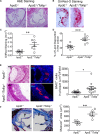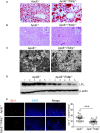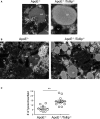Tollip Deficiency Alters Atherosclerosis and Steatosis by Disrupting Lipophagy
- PMID: 28396568
- PMCID: PMC5532987
- DOI: 10.1161/JAHA.116.004078
Tollip Deficiency Alters Atherosclerosis and Steatosis by Disrupting Lipophagy
Abstract
Background: Compromised lipophagy with unknown mechanisms may be critically involved in the intracellular accumulation of lipids, contributing to elevated atherosclerosis and liver steatosis. We hypothesize that toll-interacting protein (Tollip), a key innate immune molecule involved in the fusion of autolysosome, may play a significant role in lipophagy and modulate lipid accumulation during the pathogenesis of atherosclerosis and liver steatosis.
Methods and results: By comparing mice fed with either a Western high-fat diet or a regular chow diet, we observed that both atherosclerosis and liver steatosis were aggravated in apolipoprotein E-deficient (ApoE-/-)/Tollip-/- mice as compared with ApoE-/- mice. Through electron microscopy analyses, we observed compromised fusion of lipid droplets with lysosomes within aortic macrophages as well as liver hepatocytes from ApoE-/-/Tollip-/- mice as compared with ApoE-/- mice. As a molecular indicator for disrupted lysosome fusion, the levels of p62 were significantly elevated in aortic and liver tissues from ApoE-/-/Tollip-/- mice. Molecules involved in facilitating lipophagy completion such as Ras-related protein 7 and gamma-aminobutyric acid receptor-associated protein were reduced in ApoE-/-/Tollip-/- mice as compared with ApoE-/- mice. Intriguingly, ApoE-/-/Tollip-/- mice had reduced circulating levels of inflammatory cytokines such as tumor necrosis factor-α and increased levels of transforming growth factor-β. The reduced inflammation due to Tollip deficiency is consistent with a stable atherosclerotic plaque phenotype with increased levels of plaque collagen and smooth muscle cells in ApoE-/-/Tollip-/- mice.
Conclusions: Tollip deficiency selectively leads to enlarged yet stable atherosclerotic plaques, increased circulating lipids, liver steatosis, and reduced inflammation. Compromised lipophagy and reduced expression of inflammatory mediators due to Tollip deficiency may be the underlying causes. Our data suggest that lipid accumulation and inflammation may be intertwined yet independent processes during the progression of atherosclerosis and steatosis.
Keywords: Tollip; animal model cardiovascular disease; atherosclerosis; hyperlipidemia; inflammation; lipophagy.
© 2017 The Authors. Published on behalf of the American Heart Association, Inc., by Wiley.
Figures








Similar articles
-
Hyperlipidemia induces typical atherosclerosis development in Ldlr and Apoe deficient rats.Atherosclerosis. 2018 Apr;271:26-35. doi: 10.1016/j.atherosclerosis.2018.02.015. Epub 2018 Feb 12. Atherosclerosis. 2018. PMID: 29459263
-
Insulin-Like Growth Factor-1 Receptor Deficiency in Macrophages Accelerates Atherosclerosis and Induces an Unstable Plaque Phenotype in Apolipoprotein E-Deficient Mice.Circulation. 2016 Jun 7;133(23):2263-78. doi: 10.1161/CIRCULATIONAHA.116.021805. Epub 2016 May 6. Circulation. 2016. PMID: 27154724 Free PMC article.
-
Melanocortin 1 Receptor Deficiency Promotes Atherosclerosis in Apolipoprotein E-/- Mice.Arterioscler Thromb Vasc Biol. 2018 Feb;38(2):313-323. doi: 10.1161/ATVBAHA.117.310418. Epub 2017 Dec 28. Arterioscler Thromb Vasc Biol. 2018. PMID: 29284608 Free PMC article.
-
Mouse models of atherosclerosis and their suitability for the study of myocardial infarction.Basic Res Cardiol. 2020 Nov 30;115(6):73. doi: 10.1007/s00395-020-00829-5. Basic Res Cardiol. 2020. PMID: 33258000 Free PMC article. Review.
-
Bibliometric analysis of lipophagy:2013 to 2023.Heliyon. 2024 Aug 2;10(15):e35299. doi: 10.1016/j.heliyon.2024.e35299. eCollection 2024 Aug 15. Heliyon. 2024. PMID: 39165945 Free PMC article. Review.
Cited by
-
TFEB: A Emerging Regulator in Lipid Homeostasis for Atherosclerosis.Front Physiol. 2021 Feb 17;12:639920. doi: 10.3389/fphys.2021.639920. eCollection 2021. Front Physiol. 2021. PMID: 33679452 Free PMC article. Review.
-
TOLLIP deficiency is associated with increased resistance to Legionella pneumophila pneumonia.Mucosal Immunol. 2019 Nov;12(6):1382-1390. doi: 10.1038/s41385-019-0196-7. Epub 2019 Aug 28. Mucosal Immunol. 2019. PMID: 31462698 Free PMC article.
-
New Insights Into the Role of Autophagy in Liver Surgery in the Setting of Metabolic Syndrome and Related Diseases.Front Cell Dev Biol. 2021 Jun 1;9:670273. doi: 10.3389/fcell.2021.670273. eCollection 2021. Front Cell Dev Biol. 2021. PMID: 34141709 Free PMC article. Review.
-
Tollip Negatively Regulates Vascular Smooth Muscle Cell-Mediated Neointima Formation by Suppressing Akt-Dependent Signaling.J Am Heart Assoc. 2018 Jun 10;7(12):e006851. doi: 10.1161/JAHA.117.006851. J Am Heart Assoc. 2018. PMID: 29887521 Free PMC article.
-
Guidelines for the use and interpretation of assays for monitoring autophagy (4th edition)1.Autophagy. 2021 Jan;17(1):1-382. doi: 10.1080/15548627.2020.1797280. Epub 2021 Feb 8. Autophagy. 2021. PMID: 33634751 Free PMC article.
References
-
- Braunwald E. Shattuck lecture–cardiovascular medicine at the turn of the millennium: triumphs, concerns, and opportunities. N Engl J Med. 1997;337:1360–1369. - PubMed
-
- Burns K, Clatworthy J, Martin L, Martinon F, Plumpton C, Maschera B, Lewis A, Ray K, Tschopp J, Volpe F. Tollip, a new component of the IL‐1RI pathway, links IRAK to the IL‐1 receptor. Nat Cell Biol. 2000;2:346–351. - PubMed
MeSH terms
Substances
Grants and funding
LinkOut - more resources
Full Text Sources
Other Literature Sources
Medical
Molecular Biology Databases
Research Materials
Miscellaneous

